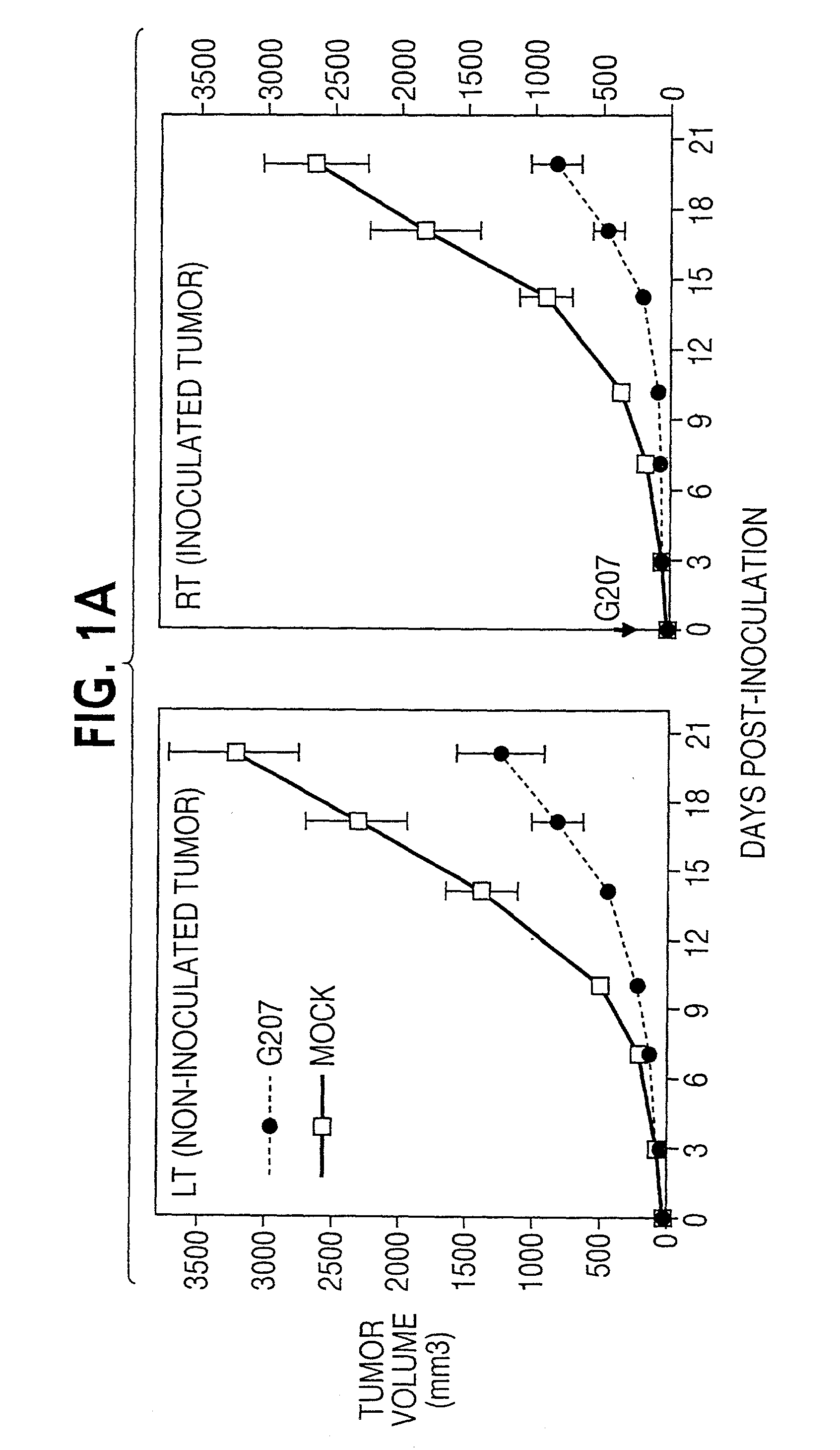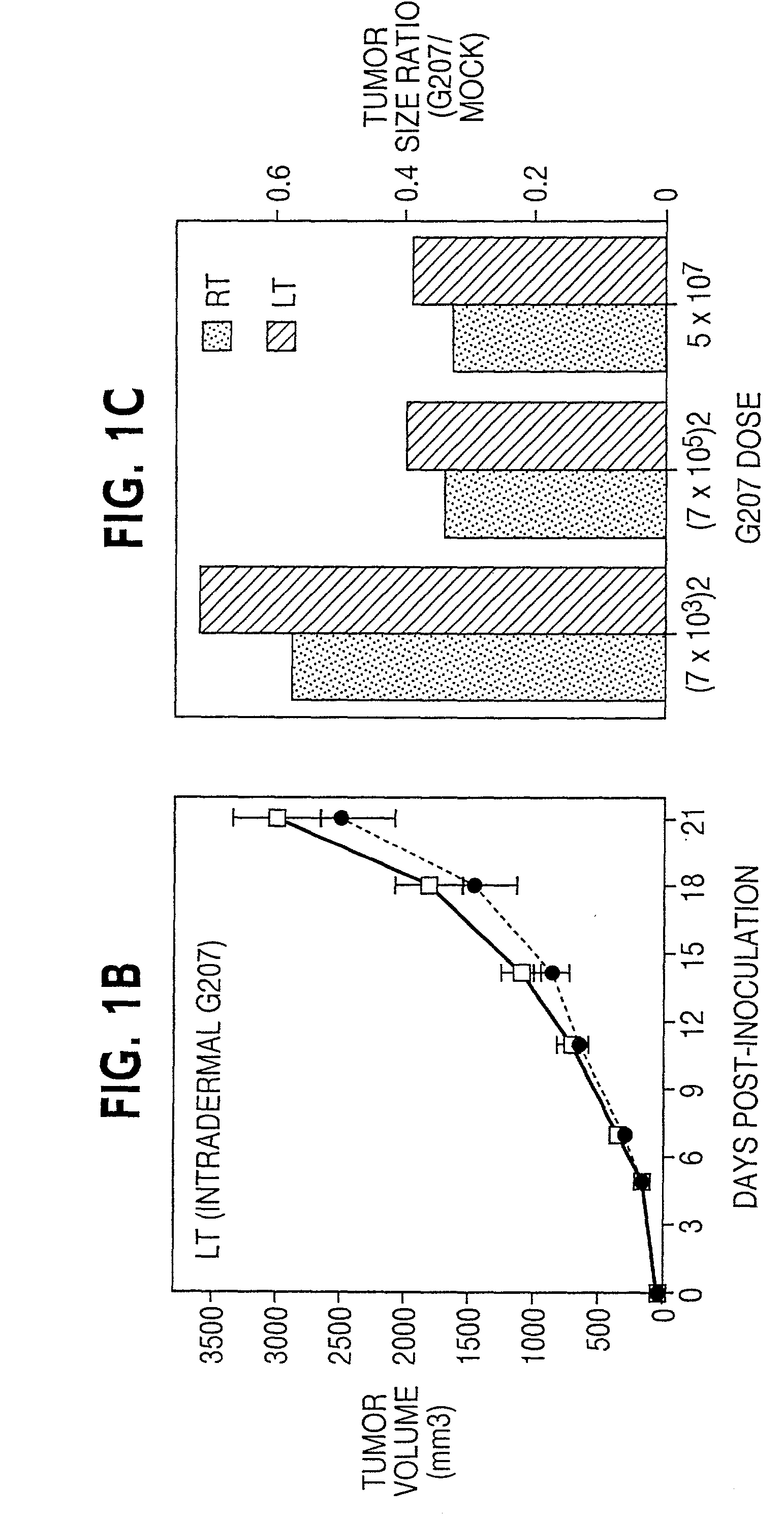Use of herpes vectors for tumor therapy
a technology of herpes and tumors, applied in the field of tumor specific immunity induction, can solve the problems of major difficulties in the therapeutic use of "cancer vaccines"
- Summary
- Abstract
- Description
- Claims
- Application Information
AI Technical Summary
Benefits of technology
Problems solved by technology
Method used
Image
Examples
example 1
[0074] Antitumor Efficacy of G207 in CT26 Cell Line
[0075] The antitumor efficacy of G207 was evaluated in a bilateral, established subcutaneous tumor model with CT26 cells as described below.
[0076] Cell Line
[0077] The murine colorectal carcinoma CT26 cell line has been widely used as a syngeneic tumor model to study immunotherapy. Fearon et al. Cancer Res. 35: 2975-80 (1988); Wang, et al., J Immunol. 154: 4685-92 (1995); Huang et al., Proc. Natl. Acad. Sci. USA 93: 9730-35 (1996). CT26 is a transplantable colon epithelial tumor induced by intrarectal injections of N-nitroso-N-methylurethane in female BALB / c mice (H-2.sup.d). Corbett et al., Cancer Res. 35: 2434-39 (1975).
[0078] In normal mice, CT26 is poorly immunogenic: 10.sup.3-10.sup.4 cells can cause a lethal tumor and do not induce detectable tumor-specific CTL. Fearon et al., supra; Wang et al., supra. AH1, a nonmutated nonamer derived from the envelop protein (gp70) of an endogenous ecotropic murine leukemia provirus (MuLV), ...
example 2
[0097] Antitumor Efficacy of G207 in M3 Mouse Melanoma Cells
[0098] M3 mouse melanoma cells (3.times.10.sup.5) were inoculated bilaterally into the flanks of DBA / 2 mice. When the tumors were 5 mm in maximal diameter, the right flank tumor was inoculated one time with either 5.times.10.sup.7 pfu of G207 or an equivalent amount of mock Vero cell preparation (as a negative control).
[0099] Inoculation with G207 inhibited the growth of the inoculated tumor (p<0.0005), and also significantly inhibited the growth of the non-inoculated tumor (p<0.02). FIG. 2.
example 3
[0100] Antitumor Efficacy of G207 in Mouse N18 Neuroblastoma Cells
[0101] Bilateral Subcutaneous Tumors
[0102] Mouse N18 neuroblastoma cells were subcutaneously implanted bilaterally into syngeneic A / J mice. Eight days after tumor implantation, 10.sup.7 pfu of G207 or mock were injected into the left tumor. In six of eight animals, inoculation with G207 resulted in the disappearance of the tumors on both sides. FIG. 3.
[0103] Subcutaneous and Intracerebral Tumors
[0104] N18 neuroblastoma cells were subcutaneously implanted bilaterally into the left flank of A / J mice. Three days later, N18 neuroblastoma cells were intracerebrally implanted into the right frontal lobe of the mice. On days 10 and 13, the subcutaneous tumors only were injected with G207 (11 mice) or mock (11 mice). Within 35 days of cerebral implantation, all mock-treated mice died from or had intracerebral tumors. Four out of eleven mice treated with G207 had no intracerebral tumors, and one G207-treated mouse was a long-t...
PUM
| Property | Measurement | Unit |
|---|---|---|
| temperature | aaaaa | aaaaa |
| temperature | aaaaa | aaaaa |
| body temperature | aaaaa | aaaaa |
Abstract
Description
Claims
Application Information
 Login to view more
Login to view more - R&D Engineer
- R&D Manager
- IP Professional
- Industry Leading Data Capabilities
- Powerful AI technology
- Patent DNA Extraction
Browse by: Latest US Patents, China's latest patents, Technical Efficacy Thesaurus, Application Domain, Technology Topic.
© 2024 PatSnap. All rights reserved.Legal|Privacy policy|Modern Slavery Act Transparency Statement|Sitemap



